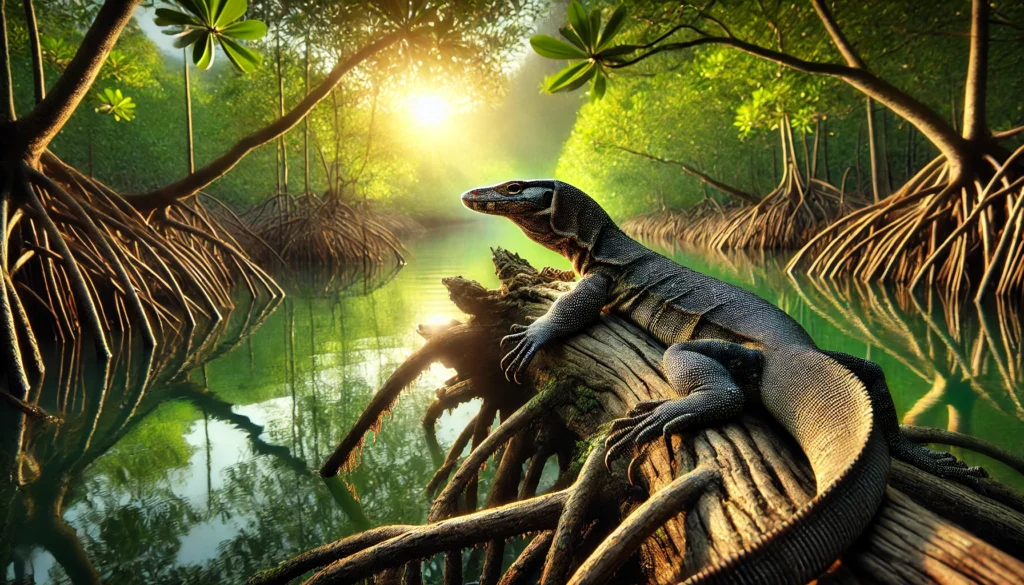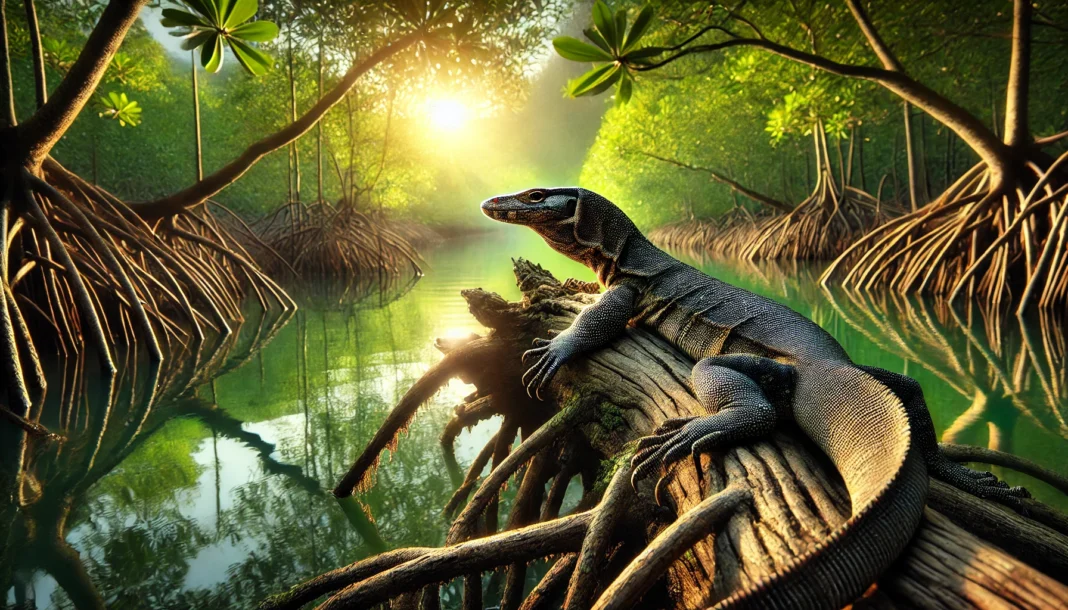Beginning
A remarkable species of monitor lizard endemic to the coastal areas of Southeast Asia and northern Australia, the mangrove monitor (Varanus indicus) is renowned for its unique look and great swimming skills. This lizard is a vital component of the ecology in mangrove forests, where it helps to preserve ecological equilibrium.
This paper will look at the mangrove monitor’s native habitat, physical characteristics, behavior, and conservation status. Whether you love nature or are more interested in reptile creatures, knowing the mangrove monitor may be an eye-opening experience.

Mangrove Monitor Physical Qualities
Usually measuring up to 1.5 meters (about 5 feet), mangrove monitors are medium-sized reptiles. Their lengthy, strong bodies, keen claws, and flat heads all allow them to easily move through their native surroundings.
Among the remarkable physical characteristics of the mangrove monitor are:
Scales and Camouflage
Their scales are usually coarse and patterned, sometimes with black marks on their lighter-colored bodies. This gives them concealment from predators and helps them fit within the mangrove ecosystem.
Tail
Long and strong, the tail of the mangrove monitor helps in swimming and balance. In their coastal environment, rapid and nimble movements depend on this tail.
Coloration
Mangrove monitors’ hue varies from greenish to dark brown with paler undersides. This color scheme makes it simpler to seek for prey by helping them fit into the environment.
Habitat and Range
Mostly in coastal areas, particularly in mangrove swamps, beaches, and wooded islands, the mangrove monitor may be found. These environments give the monitor plenty of hiding spots from predators and rich food supplies.
Most often, mangrove monitors are found in nations including Indonesia, the Philippines, Papua New Guinea, and northern Australia. Their capacity to thrive on both land and water makes them well-suited for these settings, since they frequently swim between islands and mangrove regions in quest of food.
Hunting Practices and Diet
Carnivorous mangrove monitors mostly consume tiny animals, insects, and sometimes eggs. Using their fast reflexes and strong claws, they are great predators who grab animals. The mangrove monitor is also known to scavenge, consuming the carcasses of deceased animals when available.
Their food might consist of:
- Small mammals: Like birds and rodents.
- Fish and amphibians: Excellent swimmers, fish and amphibians frequently plunge into the water to catch fish.
- Insects: Other little invertebrates as well as beetles and crickets.
Social Structure and Behavior
Except during breeding season, mangrove monitors are solitary animals who want to live alone. Territorial, they will usually drive away other monitors invading their area. Spending much of their time near water or perched in trees or shrubs, these reptiles are quick climbers and swimmers.
Though mostly active during the day, they are opportunistic eaters and will hunt at night if the chance presents itself. Their great vision enables them to find prey in water as well as on land.
State of Conservation
Though not regarded as endangered, the mangrove monitor is classified by the International Union for Conservation of Nature (IUCN) as a species of least concern. But, like many other species, it suffers from habitat loss, especially in places where mangrove forests are being destroyed for construction or farmland.
The existence of the mangrove monitor depends on conservation initiatives safeguarding mangrove environments. Preserving mangrove forests not only protects this species but also promotes coastal area biodiversity.
Read About: White Dual Monitor Stand for Reception Desk: The Ideal Solution for Your Office
FAQs About the Mangrove Monitor
Where in the wild could I locate mangrove monitors?
Found in coastal areas of Southeast Asia, northern Australia, and the Pacific islands, mangrove monitors especially inhabit mangrove forests and coastal environments.
Do mangrove monitors pose risk to people?
Although they have pointed fangs and claws, mangrove monitors are not usually hostile towards people. They usually shun contact and will only go protective if under threat.
What is the diet of mangrove monitors?
Being carnivorous, they consume insects, amphibians, fish, birds, small mammals, and other animals. They could also look for food via scavenging.
What is the lifespan of mangrove monitors?
In the wild, mangrove monitors may live for up to ten years; their longevity in captivity may be lower depending on various environmental conditions.
How can I safeguard mangrove monitors?
Preserving the mangrove monitor and other species that rely on these environments depends on protecting mangrove ecosystems and lowering habitat loss.
Final thoughts
A intriguing species, the mangrove monitor is rather important for the ecosystems of northern Australia and Southeast Asia. Its unusual physical traits, great swimming ability, and important contribution to ecological balance make it a valuable animal to study and conserve. Though not already endangered, habitat loss endangers its ongoing existence and underlines the need of conservation initiatives to safeguard mangrove forests. Protecting these vital ecosystems guarantees the preservation not just of the mangrove monitor but also the general biodiversity of coastal areas.


